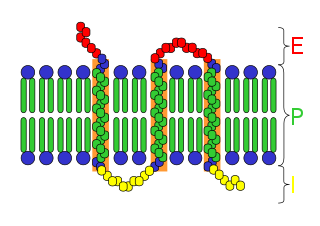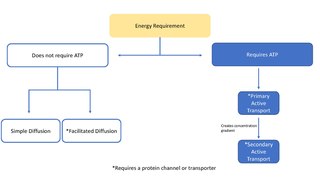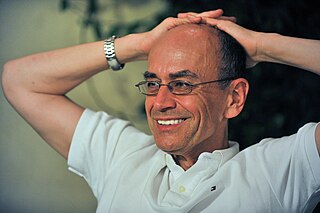
An integral, or intrinsic, membrane protein (IMP) is a type of membrane protein that is permanently attached to the biological membrane. All transmembrane proteins are IMPs, but not all IMPs are transmembrane proteins. IMPs comprise a significant fraction of the proteins encoded in an organism's genome. Proteins that cross the membrane are surrounded by annular lipids, which are defined as lipids that are in direct contact with a membrane protein. Such proteins can only be separated from the membranes by using detergents, nonpolar solvents, or sometimes denaturing agents.

A transmembrane protein (TP) is a type of integral membrane protein that spans the entirety of the cell membrane. Many transmembrane proteins function as gateways to permit the transport of specific substances across the membrane. They frequently undergo significant conformational changes to move a substance through the membrane. They are usually highly hydrophobic and aggregate and precipitate in water. They require detergents or nonpolar solvents for extraction, although some of them (beta-barrels) can be also extracted using denaturing agents.
A membrane transport protein is a membrane protein involved in the movement of ions, small molecules, and macromolecules, such as another protein, across a biological membrane. Transport proteins are integral transmembrane proteins; that is they exist permanently within and span the membrane across which they transport substances. The proteins may assist in the movement of substances by facilitated diffusion or active transport. The two main types of proteins involved in such transport are broadly categorized as either channels or carriers. The solute carriers and atypical SLCs are secondary active or facilitative transporters in humans. Collectively membrane transporters and channels are known as the transportome. Transportomes govern cellular influx and efflux of not only ions and nutrients but drugs as well.

In a neuron, synaptic vesicles store various neurotransmitters that are released at the synapse. The release is regulated by a voltage-dependent calcium channel. Vesicles are essential for propagating nerve impulses between neurons and are constantly recreated by the cell. The area in the axon that holds groups of vesicles is an axon terminal or "terminal bouton". Up to 130 vesicles can be released per bouton over a ten-minute period of stimulation at 0.2 Hz. In the visual cortex of the human brain, synaptic vesicles have an average diameter of 39.5 nanometers (nm) with a standard deviation of 5.1 nm.

Hartmut Michel is a German biochemist, who received the 1988 Nobel Prize in Chemistry for determination of the first crystal structure of an integral membrane protein, a membrane-bound complex of proteins and co-factors that is essential to photosynthesis.

In biology, a transporter is a transmembrane protein that moves ions across a biological membrane to accomplish many different biological functions including, cellular communication, maintaining homeostasis, energy production, etc. There are different types of transporters including, pumps, uniporters, antiporters, and symporters. Active transporters or ion pumps are transporters that convert energy from various sources—including adenosine triphosphate (ATP), sunlight, and other redox reactions—to potential energy by pumping an ion up its concentration gradient. This potential energy could then be used by secondary transporters, including ion carriers and ion channels, to drive vital cellular processes, such as ATP synthesis.
Neurotransmitter transporters are a class of membrane transport proteins that span the cellular membranes of neurons. Their primary function is to carry neurotransmitters across these membranes and to direct their further transport to specific intracellular locations. There are more than twenty types of neurotransmitter transporters.

A transport protein is a protein that serves the function of moving other materials within an organism. Transport proteins are vital to the growth and life of all living things. There are several different kinds of transport proteins.

Avraham Ofek was a multidisciplinary Israeli artist.

V-type proton ATPase subunit G 2 is an enzyme that in humans is encoded by the ATP6V1G2 gene.

Pinchas Cohen Gan is an Israeli painter and mixed-media artist. He was awarded the Sandberg Prize (1979), the Culture and Sport Ministry's prize for his life's work (2005), and the Israel Prize in Art (2008).

Thomas Christian Südhof, ForMemRS, is a German-American biochemist known for his study of synaptic transmission. Currently, he is a professor in the school of medicine in the department of molecular and cellular physiology, and by courtesy in neurology, and in psychiatry and behavioral sciences at Stanford University.
Peter Leslie Dutton FRS is a British biochemist, and Eldridge Reeves Johnson Professor of Biochemistry and Biophysics in the Perelman School of Medicine at the University of Pennsylvania. He is a 2013 recipient of the John Scott Award for his work on electron transfer, studying the organization of electrons in cells and the mechanisms by which they convert light or oxygen into energy for the cell.

Ron Shamir is an Israeli professor of computer science known for his work in graph theory and in computational biology. He holds the Raymond and Beverly Sackler Chair in Bioinformatics, and is the founder and former head of the Edmond J. Safra Center for Bioinformatics at Tel Aviv University.

Daniel Chamovitz is an American-born plant geneticist and the 7th President of Ben-Gurion University of the Negev in Beer-Sheva, Israel. Previously he was Dean of the George S. Wise Faculty of Life Sciences at Tel Aviv University, Israel, and the director of the multidisciplinary Manna Center Program in Food Safety and Security.

David Adika is an Israeli photographer and educator.
Osnat Penn, born in 1981, is an Israeli computational biologist whose work focuses on molecular evolution, cell research, and immunoinformatics. She is the third Israeli scientist in three years to win the UNESCO-L’Oréal fellowship, which she received in 2013 for her work on the genetic origins of autism. Penn is currently a postdoctorate fellow at the University of Washington in Seattle, where she has been working since 2012.

Shimon Schuldiner is an Israeli biochemist. He has made important contributions to the understanding of proteins that couple the movement of ions and other molecules across membranes. Schuldiner is Mathilda Marks-Kennedy Professor at the Alexander Silberman Institute of Life Sciences, the Hebrew University of Jerusalem. He received a B.Sc. in 1967 and an M.Sc. in 1968 from the Hebrew University of Jerusalem, and a Ph.D. from the Weizmann Institute of Science in Rehovot in 1973.

Dan Peer is a Professor and the Director of the Laboratory of Precision NanoMedicine at Tel Aviv University (TAU). He is also the Vice President for Research and Development at TAU. In 2017 he co-founded and acts as the managing director of SPARK Tel Aviv, Center for Translational Medicine. From 2016–2020 he was the chair of the TAU Cancer Biology Research Center.
Bezalel Bar-Kochva is a professor emeritus in the Department of Jewish History at Tel Aviv University. He is a historian of the Hellenistic period, the three centuries after the conquests of Alexander the Great, and the Second Temple period of Judaism. Bar-Kochva's research focuses on Judea, the Land of Israel, diaspora Jews, and the Seleucid Empire in that era. Notably, he has written extensively on the military history of the Maccabean Revolt as well as Greek views on Judaism and Jewish adaptation to Greek culture during the Hellenistic era.















